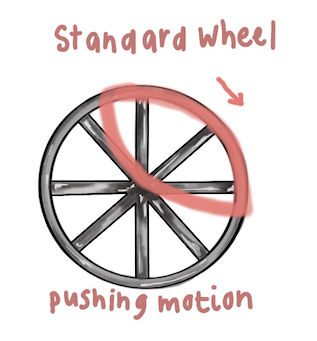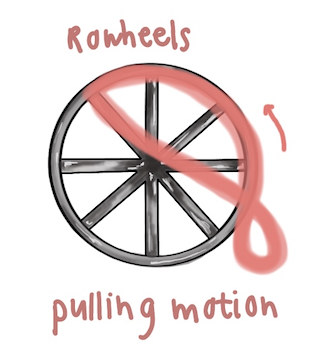Lay summary by Paula Cameron
Edited by Crystal Han
This is a lay summary of a research article by Dr. Bonita Sawatzky and her colleagues Alireza Habibi, Megan MacGillivray and Harleen Kalra. Read the original article here.
What was the purpose of the study?
There are different types of wheelchairs that user various methods of propulsion. This study compared forward propulsion, which uses conventional pushing motion, and rearward propulsion, which uses a rowing-like pulling motion.


A typical wheelchair uses forward propulsions with standard handrim, whereas the wheelchair fitted with “Rowheels” uses rearward propulsion with high or low geared wheels and an oval-shaped handrim. In this study, the researchers wanted to determine which propulsion style had a higher gross mechanical efficiency (GME) and a lower rate of perceived exertion (RPE) using high geared wheels.
GME is essentially the ratio of how much work is done (power output) compared to how much energy is expended (VO2) during the motion. Also, the Rate of Perceived Exertion was asked from each participation on the Borg scale, a scale from 6 to 20 on which “6” is very easy and “20” is maximal.
How was the study done?
Fourteen able-bodied males between the ages of 19 to 65 with no previous experience using a manual wheelchair were recruited to take part in this study. They participated in two different sessions: a training session to get comfortable with both types of wheelchairs, followed by a testing session. Both the practice and testing session were conducted on a treadmill. The order of the testing was random: some participants started with the standard wheels, and others started with the Rowheels. During each 5 minute test, heart rate, oxygen uptake, and perceived effort were measured.
What were the results?
Results demonstrated that the gross mechanical efficiency was significantly lower, and that the rate of perceived exertion was higher for the Rowheels. Another interesting result was that the Rowheels required approximately ten fewer strokes every minute, and that allowed the wheelchair to travel a greater distance with each stroke. The Rowheels stroke effectiveness was significantly higher. Despite these apparent advantages of the Rowheels, most participants felt that the standard wheels required less effort than the Rowheels.
Why does this study matter?
This study is important because it is another step towards exploring how to reduce the amount of energy required for wheeled mobility. While cycling and walking have mechanical efficiencies over 20%, wheelchair GME 8 is around 5%. Although Rowheels used more energy, the rowing muscles are larger and should fatigue less over time. Thus, it may be beneficial for longer distances over traditional wheels. Continual effort towards innovation is important in finding ways to improve function.
What were the limitations?
One of the limitations is that the study used able-bodied participants with no wheelchair experience. The reason behind this decision was that experienced wheelchair users might already have adapted to a certain type of wheelchair. The geared system of the Rowheels may actually cost energy during a treadmill testing environment, and only at a steady state speed. This may give different results than using a wheelchair on the ground in everyday life and over longer distances.

